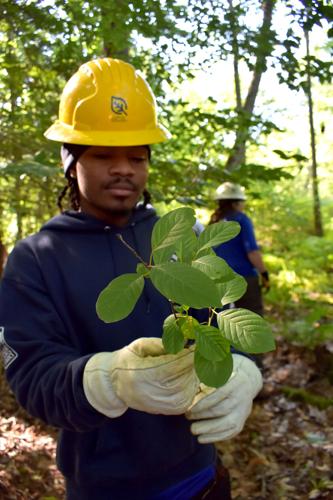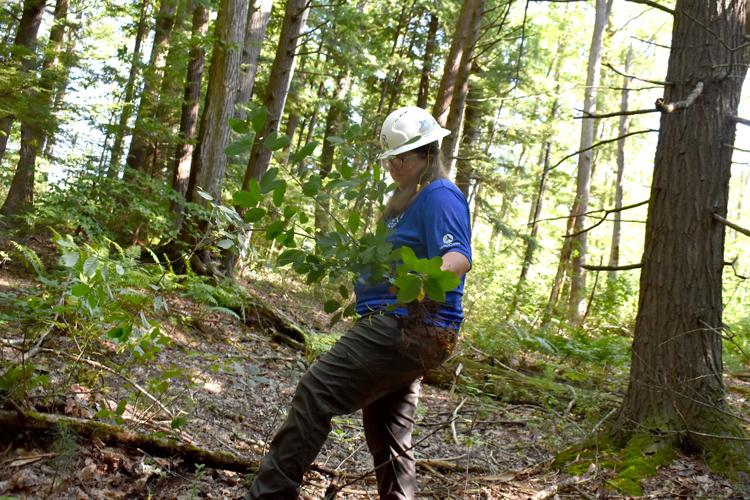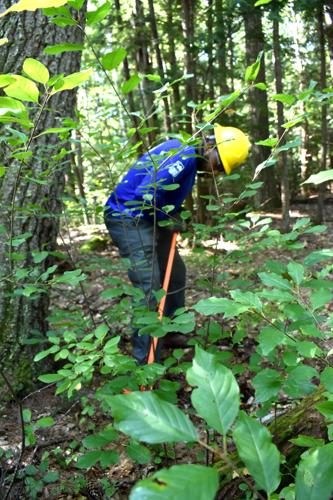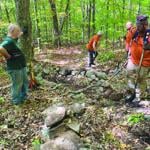BELMONT — The crew from the Student Conservation Association are from all over the country. To them, the woods along the Tioga River are a beautiful, natural ecosystem, with a variety of tree species, wildlife and a cartoonish diversity of mushrooms bursting from the spongy forest floor.
But it’s also an ecosystem in need of help, which is why they’re there this month, performing the arduous task of beating back the spread of glossy buckthorn, an invasive shrub that, if left alone, would slowly eliminate the diversity of that stretch of woods.
Glossy buckthorn, according to the University of New Hampshire Cooperative Extension, is a shrub or small tree native to Eurasia. It’s considered invasive in North America because of its ability to grow quickly and to sprout leaves sooner than native plants, thereby shading out sprouting plants that would otherwise contribute to a diversity of flora.
In the woods between Route 140 and Gardners Grove Road, just south of Silver Lake and near the start of the Tioga River, buckthorn is already “substantial” in its occurrence, said James Rowland, co-crew leader of the SCA team tackling the problem. Their strategy is not eradication — that would be nearly impossible, at this point — but they can intervene in the competition between native and invasive plants to level the playing field.
Glossy buckthorn’s advantage is in its speed. Small seedlings, likely sprouted from berries eaten and then excreted by birds, fill the forest floor. The shrubs grow spindly shrubs when under the shade of the canopy, but when a mature tree falls as part of the natural forest cycle, the buckthorn leaps into action, filling the sunny patch with a dense thicket, preventing a new seedling from growing into a tree to replace the one that fell.
Over time, this process repeats, and the ecosystem that today appears rich with diversity could become nothing but buckthorn. Brenda Kirlin, a crew member from San Antonio, Texas, said, “It creates a monoculture, and that’s not good for habitat, wildlife, insects, and it doesn’t capture much carbon.”
“It’s not good for the local watershed, either,” added Avery Ryan, co-crew leader who comes from Atlanta. Buckthorn sprouts quickly, partly because it doesn’t spend much time growing roots. Compared to buckthorn, trees do a much better job of sending their root systems deep into the ground, preventing soil erosion and filtering groundwater.
The crew convened in Belmont on Aug. 20, and will spend about 10 days working in the Tioga Conservation Area. They’re pulling small shrubs by hand, using a tool called a “weed wrench” for the more established plants, and collecting their harvest into piles. The plants will be sandwiched between tarps and left to dry out, so they cannot re-root.
It’s hard work, said Mel Brown, who comes from Oakland, California and hopes to become a firefighter. But, he said, “I think it’s rewarding. At times it can be strenuous, it’s all about being rested, getting proper hydration and nutrition. It can be relaxing and insightful to work with people who know so much more about ecology and wilderness than you.”
Brown said he’s been struck by the amount of wilderness he’s encountered this summer through his work with the SCA.
“Being this far northeast is very eye-opening,” he said. “Very rewarding, life-changing for sure.”
Kristen Hall, who is working toward earning a doctorate of philosophy in biology, lives in New York. He said the work is “taxing and exhausting,” but that “there’s nothing I’ve wanted more in my life. ... This is the first time I’ve been around so much wildlife.”
Ashley Chastain, from Mobile, Alabama, said she joined the SCA in 2018, a direct result of the 2010 BP oil spill in the Gulf of Mexico. “It changed how I look at nature, and how precious of a resource it is.” She’s now moving toward a supervisory role within the SCA.
Chastain, who said she once thought she would spend her whole life in Mobile, called her experience working in conservation “life-altering, in the best way possible.”
The SCA crew is funded through a National Fish and Wildlife Foundation grant awarded to the Belknap County Conservation District. The grant, $87,000 in total, is being applied to a multi-year schedule of projects that includes sites in Alton, Belmont, Gilmanton, Meredith and Sanbornton.
The Belmont project includes collaboration from the Belmont Conservation Commission. Denise Naiva, Belmont conservation chair, said, “We are pleased to work with BCCD and SCA to help protect and improve town land in the Tioga Conservation Area. It is exciting to work with these young people to put our plan into action.”




















(0) comments
Welcome to the discussion.
Log In
Keep it Clean. Please avoid obscene, vulgar, lewd, racist or sexually-oriented language.
PLEASE TURN OFF YOUR CAPS LOCK.
Don't Threaten. Threats of harming another person will not be tolerated.
Be Truthful. Don't knowingly lie about anyone or anything.
Be Nice. No racism, sexism or any sort of -ism that is degrading to another person.
Be Proactive. Use the 'Report' link on each comment to let us know of abusive posts.
Share with Us. We'd love to hear eyewitness accounts, the history behind an article.